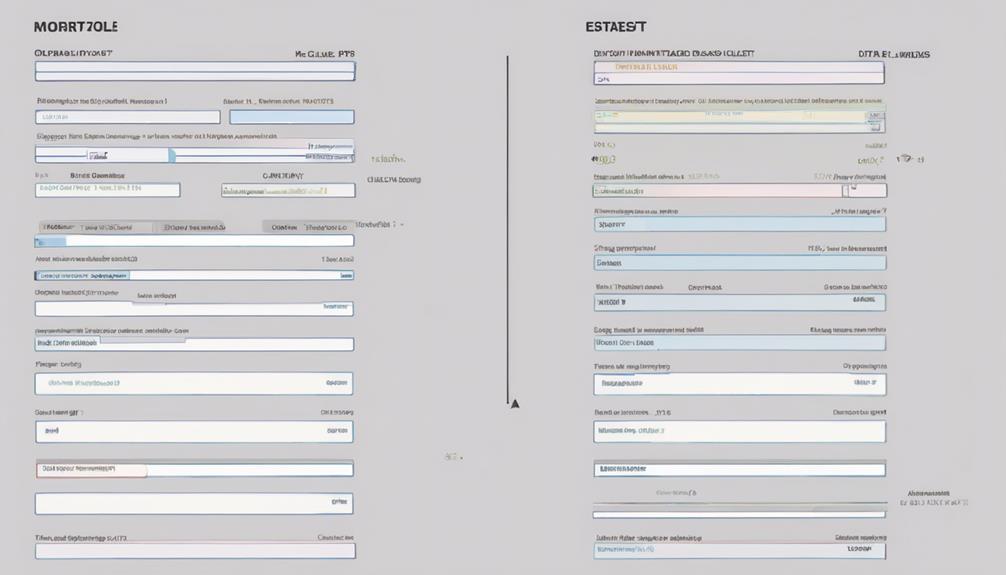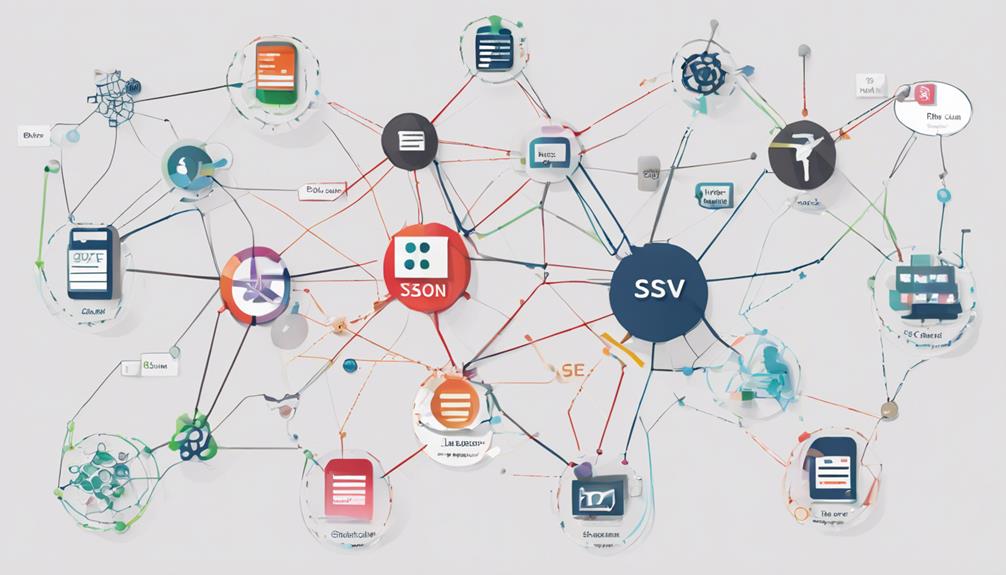When it comes to database data formatting, you might wonder how it truly benefits businesses. Well, imagine unlocking the potential of your data to make informed decisions swiftly, leading to a competitive edge in your industry. But that’s just the beginning. By optimizing data structures and ensuring consistency, you pave the way for operational excellence and streamlined processes. So, how exactly does this all come together to propel your business forward? Let’s explore the intricate web of advantages that await when your data is formatted just right.
Enhances Decision Making
Utilizing a well-structured database system significantly enhances decision-making processes within businesses. By organizing and storing data efficiently, businesses can access accurate information promptly, leading to informed decision-making. This increased access to data translates to improved productivity as employees spend less time searching for information and more time analyzing it.
Furthermore, a well-maintained database boosts performance by providing real-time insights into various aspects of the business. With up-to-date data readily available, managers can quickly identify trends, track key performance indicators, and make strategic decisions promptly. This agility in decision-making can give businesses a competitive edge in today’s fast-paced market environment.
In essence, the streamlined access to data that a database system provides increases productivity and boosts performance by enabling quicker and more effective decision-making processes. Businesses that leverage well-structured databases can stay ahead of the curve and adapt swiftly to changing market conditions.
Improves Efficiency
Streamlining data organization through proper formatting can significantly improve efficiency in your business operations. By ensuring data accuracy, you reduce the likelihood of errors and save time that would otherwise be spent on rectifying mistakes. This structured approach facilitates data analysis, allowing you to extract valuable insights swiftly and make informed decisions.
Streamlines Data Organization
By organizing your database data effectively, you can significantly enhance the efficiency of your business operations. Data classification and categorization play a crucial role in streamlining data organization. When data is classified based on specific criteria such as customer demographics or product categories, it becomes easier to locate and retrieve information promptly. Additionally, data standardization and normalization ensure that all data entries are uniform and consistent across the database. This uniformity eliminates discrepancies and reduces the risk of errors in data analysis and decision-making processes.
Efficient data organization enables quick access to relevant information, leading to improved decision-making and operational effectiveness. By streamlining data organization through proper classification, categorization, standardization, and normalization, businesses can optimize their workflows, minimize data redundancy, and enhance overall productivity. Moreover, organized data allows for better tracking of key performance indicators and trends, enabling businesses to make informed decisions based on accurate and up-to-date information. Streamlining data organization is a fundamental step towards maximizing the efficiency and effectiveness of your business processes.
Enhances Data Accuracy
Efficient data organization not only streamlines your business operations but also plays a key role in enhancing data accuracy. By ensuring data integrity through proper formatting, you can significantly improve the quality and reliability of the information stored in your database. Data integrity refers to the accuracy and consistency of data throughout its lifecycle. When data is formatted correctly, it becomes easier to perform data validation processes, which involve checking and ensuring that data is accurate, complete, and reliable.
Validating data helps in identifying and correcting errors or inconsistencies, preventing issues that could arise from using incorrect or outdated information. By enhancing data accuracy through formatting, you can trust the data within your database, enabling better decision-making processes and reducing the risks associated with relying on faulty information. Improving data accuracy not only enhances the efficiency of your operations but also strengthens the foundation upon which your business relies for crucial insights and strategic planning.
Facilitates Data Analysis
To enhance the efficiency of your data analysis processes, proper database data formatting plays a crucial role. By ensuring that your data is structured and organized in a consistent manner, you can streamline the data analysis procedures within your business. One key benefit of well-formatted data is the facilitation of data visualization. When your data is formatted correctly, it becomes easier to represent it visually through charts, graphs, and dashboards, allowing you to quickly identify patterns and trends.
Moreover, formatted data is essential for predictive analytics. Predictive analytics leverages historical data to forecast future trends and outcomes. When your data is formatted properly, predictive models can be built more effectively, leading to more accurate predictions. This can help you make informed business decisions and stay ahead of the competition.
Reduces Errors
When implementing proper database data formatting for your business, one significant advantage is the reduction of errors. By incorporating error prevention techniques and data validation processes into your database formatting, you can significantly decrease the likelihood of inaccuracies and mistakes in your data.
Data validation ensures that the information entered into the database meets specific criteria, such as format, type, and range, reducing the chance of incorrect or inconsistent data. This validation process acts as a filter, catching errors before they become significant issues within your database.
Moreover, by establishing standardized formatting rules for your database, you can streamline the data entry process and minimize the occurrence of human errors. Consistent formatting guidelines help employees input data correctly, reducing the need for manual corrections and enhancing overall data accuracy.
Streamlines Operations
A streamlined database with properly formatted data not only reduces errors but also enhances operational efficiency for businesses. When data is normalized and consistently formatted, it simplifies processes and streamlines operations. Here’s how:
- Improved Data Integrity: Data normalization ensures that information is stored logically and reduces redundancy, leading to more accurate and reliable data.
- Efficient Data Retrieval: Consistent formatting allows for quicker and easier access to information, saving time and increasing productivity.
- Enhanced Decision-Making: With organized and standardized data, businesses can make informed decisions based on reliable information.
- Smoother Integration: Consistent data formatting facilitates the integration of different systems, making it easier to share and utilize data across various departments or platforms.
Facilitates Compliance
Regularly ensuring that your database data is properly formatted not only boosts operational efficiency but also plays a crucial role in facilitating compliance with regulatory requirements. Data integrity is essential for meeting regulatory standards, ensuring that the information stored is accurate, consistent, and secure. Properly formatted data helps in maintaining the integrity of records, preventing errors or discrepancies that could lead to compliance issues. By organizing and structuring data correctly, businesses can easily demonstrate adherence to regulatory requirements, reducing the risk of fines or penalties. Consistent formatting also enables efficient monitoring and auditing processes, making it easier to track and report on data activities as needed. Moreover, compliant data formatting fosters transparency and accountability within the organization, showcasing a commitment to upholding legal standards. Overall, aligning database data formatting with regulatory requirements is a proactive approach that safeguards both data quality and compliance integrity.
Supports Data Analysis
Supporting data analysis through database data formatting enhances the accuracy of the information you rely on for strategic decision-making. By structuring data in a standardized format, you can streamline the process of extracting insights that drive your business forward. This approach not only improves the quality of your analytics but also empowers you to make informed decisions that positively impact your bottom line.
Enhances Data Accuracy
By implementing structured data formatting within your database, you significantly enhance the accuracy of your data, thereby bolstering its effectiveness in supporting robust data analysis. Structured data formatting plays a crucial role in maintaining data integrity and ensuring high data quality. Here’s how enhancing data accuracy through formatting benefits your business:
- Improved Decision-Making: Accurate data allows for informed decision-making, leading to better outcomes.
- Enhanced Customer Insights: Accurate data provides a clearer view of customer behavior and preferences.
- Increased Operational Efficiency: Accurate data streamlines processes and reduces errors in operations.
- Facilitates Targeted Marketing: Accurate data enables precise targeting of marketing efforts, maximizing ROI.
Facilitates Decision-Making Process
Implementing structured data formatting not only enhances data accuracy but also plays a pivotal role in facilitating the decision-making process within businesses. By organizing data in a standardized format, businesses can effectively use data visualization tools to represent complex data sets in a visually appealing manner. This aids in better data interpretation, allowing stakeholders to gain valuable insights from the data presented.
Structured data formatting is crucial for making data-driven decisions and strategic planning. When data is formatted in a consistent and organized manner, it becomes easier to extract meaningful information that can guide decision-making processes. Through the use of structured data, businesses can identify trends, patterns, and correlations that provide valuable insights for strategic planning purposes. This enhances the ability of organizations to make informed decisions based on accurate and reliable data, ultimately leading to improved business performance and competitiveness.
Improves Business Insights
To enhance your business insights and support robust data analysis, structured data formatting plays a pivotal role in extracting actionable information from your databases. When your data is well-formatted, it becomes easier to uncover valuable insights that can drive strategic decision-making processes within your organization. Here’s how data formatting can improve your business insights:
- Data Visualization: Properly formatted data allows for the creation of visually appealing charts, graphs, and dashboards, making it simpler to identify trends and patterns.
- Predictive Analytics: Structured data enables the application of predictive analytics models to forecast future outcomes based on historical data trends.
- Enhanced Data Accuracy: Well-formatted data reduces errors and inconsistencies, ensuring that the insights derived are reliable and accurate.
- Improved Data Accessibility: Formatting data in a standardized manner enhances data accessibility, allowing for easier sharing and collaboration across different teams within your organization.
Frequently Asked Questions
How Does Database Data Formatting Impact Data Security?
Proper database data formatting enhances data security by enabling efficient encryption methods. It allows for effective access control, safeguarding sensitive information from unauthorized access. Ensuring data is structured correctly is crucial for maintaining the integrity and confidentiality of your database.
Can Database Data Formatting Be Automated?
When it comes to automation benefits, database data formatting can indeed be automated, leading to efficiency gains. By streamlining the process, you can save time and ensure data consistency, enhancing overall productivity in your business operations.
What Are the Common Challenges in Implementing Data Formatting?
When implementing data formatting, you may face challenges like ensuring data integrity and maintaining data consistency across systems. It requires attention to detail to avoid errors and discrepancies that could impact business operations.
Does Database Data Formatting Require Specialized Training?
You don’t need specialized training for database data formatting. It’s more about skill development than formal education. With practice, you’ll master the art of formatting data effectively, boosting your business’s efficiency and decision-making capabilities.
How Can Database Data Formatting Adapt to Changing Business Needs?
You can adapt database data formatting to changing business needs by utilizing data integration tools and business intelligence software. This approach enables you to customize data structures, enhance analytics, and support informed decision-making for optimal business performance.



